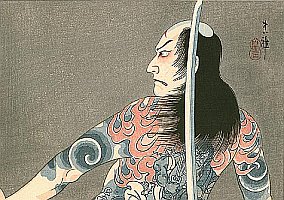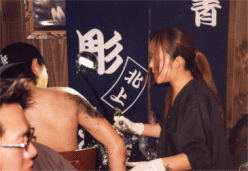|
|
|
|
Japanese Tattoo Practices |
|||

|
Japan has a long history dealing with tattoo art.
The tattoo culture of Japan started as early as the 1700s, during the Edo period. The tattoo images were taken from traditional watercolor paintings, woodcuts and picture books of the time. The common people of the era, in an attempt to separate themselves from the upper classes, began to develop their own culture. All sorts of art became an outlet of cultural expression for the common people. They rejected the old morality of Confucian beliefs of the samurai and began taking up themes of duty, human experience and feeling, fashion and comedy.
Tattoo art has maintained a negative connotation due to the prevalence of Buddhism and Confucianism. In the majority of Japanese minds a tattoo is a mark of the Japanese mafia or a macho symbol for the lower class. There is evidence that there were many who had facial tattoo art according to Chinese documents. The high class Chinese also thought tattooing was babaric. When Buddhism was brought over to Japan from China the negative influence toward tattoos followed, especially when criminals were marked with tattoos to punish them and defame them in society. This also was seen as a safety precaution to identidy criminals. Later prostitutes used tattoos to make themselves more attractive to their customers. Body tattoos were also used for laborers and fire fighters. In 1720 the tattoo punishment become official for criminals replacing the amputation of the nose and the ears. This punishment created a class of outcasts that had no place in the society and were visible to all. Although tattoos were known to criminals there were some good criminals that also were branded by tattoos. In stories like Robin Hood there were pictures with men covered in tattoos. As Japan became more Westernized the Imperial government banned tattooing because of its babaric nature and part of the past. The interesting thing was when sailors from the West came over with tattoos. The art had spread to the West just as the East was trying to get rid of it. Although some younger people may consider tattooing trendy, most of the Japanese population considers it babaric and connected to mafia and lower class. Japanese youth will usually get partial tattoos so they are not directly visible. The public bathhouses and public swimming pools in Japan banned tattooed visitors. Today, tattooed people have created their own subculture and are able to display their art freely. The modern tattoo masters are highly esteemed, and many people travel to be tattooed in Japan. The tattooing process in Japan is much more personal than in the West. The tattoo artist will usually pick a tattoo that best suits the person. They do large designs, carefully planned and drawn exclusively for each customer. Picking generic designs off the wall is not common, except for American-style parlors in the larger cities. The relationship between the tattoo master and the client is a long, committed one, involving many hours of planning and sometimes months or even years of tattooing. Most of the time Japanese artists provide a book of their own designs to give ideas, but the designs are never repeated exactly. Japanese tattoo art has developed very different from how it started. There are groups who accept tattooing and welcome it and then there are the conservative groups that feel negatively towards it.
|
||
|
|
|
||

yeah. |
|||